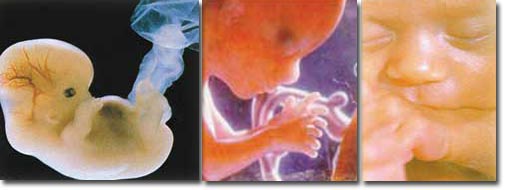 |
| Quran | Audio | Video | Miracles | Articles | Manuscripts | Webmasters | Contact |
 |
THE BIRTH OF A HUMAN BEING Many diverse subjects are mentioned in the Qur'an while also inviting people to believe. Sometimes the heavens, sometimes animals, and sometimes plants are mentioned as evidence of Allah's existence. In many of these verses, people are called upon to consider their own creation. They are often reminded how man came into the world, which stages he has passed through, and what his essence is:
The miracle of man's creation is emphasised in many verses. Some of the information within these verses is so detailed that it was impossible for anyone living in the 7th century to have known it. Examples of these are as follows: 1. Man is not created from the entire semen, but only a very small portion of it (sperm). 2. It is the male that determines the sex of the baby. 3. The human embryo adheres to the mother's uterus like a leech. 4. The embryo develops in three dark regions in the uterus. The items of information just quoted were far above the level of learning of the people living at that time. The discovery of these facts could only become possible by the technology attained in the 20th century. Now, let us examine these items one at a time. A Drop of Semen
Sperm undertake a journey into the mother's body until they reach the ovum. Only a thousand out of 250 million sperm succeed in reaching the ovum. At the end of this five-minute race, the ovum, half the size of a grain of salt, will let only one of the sperms in. That is, the substance of man is not the whole semen, but only a small part of it. This is explained in the Surat al-Qiyama as follows:
As we have seen, the Qur'an informs us that man is made not from the entire semen, but only a small part of it. That the particular emphasis in this verse announces a fact only discovered by modern science is evidence that the Qur'an is the Word of Allah. The Mixture in the Semen
The fluid referred to as semen, which contains the sperm, does not consist of sperm alone. On the contrary, it is made up of a mixture of different fluids. Seminal fluid is a collection of substances secreted from the testicles, the seminal vesicles, the prostate gland and glands linked to the urinary tract. A detailed analysis of this fluid shows that it consists of a great many separate substances, such as citric acid, prostaglandin, flavin, ascorbic acid, ergothioneine, cholesterol, phospholipids, fibrinolysin, zinc, phosphatase acid, phosphase, hyaluronidase and sperm. These fluids exercise different functions, such as containing the sugar necessary for providing energy for the sperm, neutralizing the acids at the entrance of the uterus, and providing a slippery substance for the easy movement of the sperm. When semen is mentioned in the Qur'an, this fact, which was discovered by modern science, is also referred to, and semen is defined as a mixed fluid:
In other verses, semen is again referred to as a mixture, and it is stressed that man is created from the "extract" of this mixture:
The Arabic word "sulala," translated as "extract," means the essential or best part of something. By either meaning, it refers to "part of a whole." This shows that the Qur'an is the Word of Allah, Who knows the creation of man to its minute details. The Sex of the Child Until fairly recently, it was thought that a baby's sex was determined by the mother's cells. Or at least, it was believed that the sex was determined by the male and female cells together. But, we are given different information in the Qur'an, where it is stated that masculinity or femininity is created out of "a drop of sperm which has been ejected."
The developing disciplines of genetics and molecular biology have scientifically validated the accuracy of this information given by the Qur'an. It is now understood that sex is determined by the sperm cells from the male, and that the female has no role in this process.
Chromosomes are the main elements in determining sex. Two of the 46 chromosomes that determine the structure of a human being are identified as the sex chromosomes. These two chromosomes are called "XY" in males, and "XX" in females, because the shapes of the chromosomes resemble these letters. The Y chromosome carries the genes that code for masculinity, while the X chromosome carries the genes that code for femininity.
In other words, a baby's sex is determined by which chromosome from the male unites with the female's ovum. None of this was known until the discovery of genes in the 20th century. Indeed, in many cultures, it was believed that a baby's sex was determined by the female. That was why women were blamed when they gave birth to girls. Fourteen centuries before human genes were discovered, however, the Qur'an revealed information that denies this superstition, and referred to the origin of sex lying not with women, but with the semen deriving from men. The " Alaq" Clinging to the Uterus
If we continue to examine the facts announced to us in the Qur'an, about the formation of human beings, we again encounter some very important scientific truth. When the sperm of the male unites with the ovum of the female, the essence of the baby to be born is formed. This single cell, known as a "zygote" in biology, will instantly begin reproducing by dividing, and eventually become a "piece of flesh," called an embryo. This, of course, can only be seen by human beings with the aid of a microscope. The embryo, however, does not spend its developmental period in a void. It clings to the uterus, with something like roots that is firmly fixed to the earth by its tendrils. Through this bond, the embryo can obtain the substances essential to its development from the mother's body.85 Here, an important miracle of the Qur'an is revealed. While referring to the embryo developing in the mother's womb, Allah uses the word "alaq" in the Qur'an:
The meaning of the word "alaq" in Arabic is "a thing that clings to some place." The word is literally used to describe leeches that cling to a body to suck blood. Certainly, the use of such a specific word for the embryo developing in the mother's womb, proves once again that the Qur'an is the Word of Allah, the Lord of all the Worlds. The Wrapping of Muscles over the Bones Another important item of information provided in the verses of the Qur'an is the developmental stages of a human being in the mother's womb. It is stated in these verses that in the mother's womb, the bones develop first, and then the muscles form which wrap around them.
Embryology is the branch of science that studies the development of the embryo in the mother's womb. Until very recently, embryologists assumed that the bones and muscles in an embryo developed at the same time. Yet, advanced microscopic research conducted by virtue of new technological developments has revealed that the revelation of the Qur'an is word for word correct. These observations at the microscopic level showed that the development inside the mother's womb takes place in just the way it is described in these verses. First, the cartilage tissue of the embryo ossifies. Then, muscular cells that are selected from amongst the tissue around the bones come together and wrap around the bones. This event is described in a scientific publication titled Developing Human in the following words:
In short, developmental stages of man, as described in the Qur'an, are in perfect harmony with the findings of modern embryology.
Three Dark Stages of the Baby in the Womb In the Qur'an, it is related that man is created through a three-stage process in the mother's womb.
The expression "fee thulumatin thalathin," translated into English as "a threefold darkness," indicates three dark regions involved during the development of the embryo. These are: The darkness of the abdomen The darkness of the womb The darkness of the placenta As we have seen, modern biology has revealed that the embryological development of the baby takes place in the manner revealed in the verse, in three dark regions. Moreover, advances in the science of embryology show that these regions consist of three layers each. The lateral abdominal wall comprises three layers: the external oblique, the internal oblique, and transverses abdominis muscles.87 Similarly, the wall of the womb also consists of three layers: the epimetrium, the myometrium and the endometrium.88 Similarly again, the placenta surrounding the embryo also consists of three layers: the amnion (the internal membrane around the fetus), the chorion (the middle amnion layer) and the decidua (outer amnion layer.)89 It is also pointed out in this verse that a human being is created in the mother's womb in three distinct stages.
These phases refer to the different developmental stages of a baby. In brief, the main characteristics of these developmental stages are as follows: - Pre-embryonic Stage In this first phase, the zygote grows by division, and when it becomes a cell cluster, it buries itself in the wall of the uterus. While they continue growing, the cells organize themselves in three layers. - Embryonic Stage The second phase lasts for five and a half weeks, during which the baby is referred to as an "embryo." During this stage, the basic organs and systems of the body start to appear from the cell layers. - Foetal Stage From this stage onward, the embryo is called a "foetus." This phase begins at the eighth week of gestation, and lasts until the moment of birth. The distinctive characteristic of this stage is that the foetus looks much like a human being, with its face, hands and feet. Although it is only 3 cm long initially, all of its organs have become apparent. This phase lasts for about 30 weeks, and development continues until the week of delivery. Information on the development in the mother's womb became available only after observations with modern devices. Yet, just like many other scientific facts, in a miraculous way, Allah draws our attention to these items of information in the verses of the Qur'an. The fact that such detailed and accurate information was given in the Qur'an at a time when people had scarce information on medical matters is clear evidence that the Qur'an is the Word of Allah.
85. Keith L. Moore,
et al., Human Development as Described in the Qur'an and Sunnah
(Makkah: Commission on Scientific Signs of the Qur'an and Sunnah,
1992), 36. Source: www.miraclesofthequran.com [1/1/2009] |
|
|

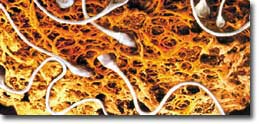
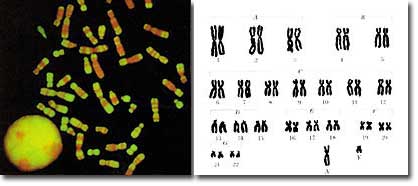
 The
formation of a new human being begins with the cross combination
of one of these chromosomes, which exist in males and females in
pairs. In females, both components of the sex cell, which divides
into two during ovulation, carry X chromosomes. The sex cell of
a male, on the other hand, produces two different kinds of sperm,
one that contains X chromosomes and the other Y chromosomes. If
an X chromosome from the female unites with a sperm that contains
an X chromosome, then the baby is female. If it unites with the
sperm that contains a Y chromosome, the baby is male.
The
formation of a new human being begins with the cross combination
of one of these chromosomes, which exist in males and females in
pairs. In females, both components of the sex cell, which divides
into two during ovulation, carry X chromosomes. The sex cell of
a male, on the other hand, produces two different kinds of sperm,
one that contains X chromosomes and the other Y chromosomes. If
an X chromosome from the female unites with a sperm that contains
an X chromosome, then the baby is female. If it unites with the
sperm that contains a Y chromosome, the baby is male.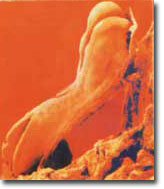
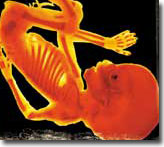
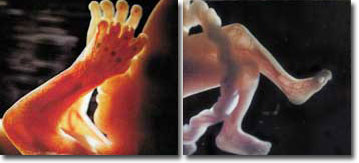
 Indeed,
modern biology has also revealed that the baby's embryological development
takes place in three distinct regions in the mother's womb. Today,
in all the embryology textbooks studied in departments of medicine,
this subject is taken as an element of basic knowledge. For instance,
in Basic Human Embryology, a fundamental reference text
in the field of embryology, this fact is stated as follows:
Indeed,
modern biology has also revealed that the baby's embryological development
takes place in three distinct regions in the mother's womb. Today,
in all the embryology textbooks studied in departments of medicine,
this subject is taken as an element of basic knowledge. For instance,
in Basic Human Embryology, a fundamental reference text
in the field of embryology, this fact is stated as follows: 